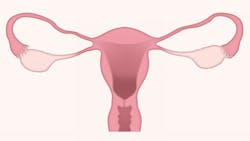Researchers pilot falloposcope for earlier ovarian cancer detection
Biomedical engineering professor and BIO5 Institute Director Jennifer Barton has spent nearly a decade developing a falloposcope to detect ovarian cancer in its early stages. Banner – University Medical Center surgeon Dr. John Heusinkveld has now used the device to capture images of study participants' fallopian tubes for the first time.
Due to a lack of effective screening and diagnostic tools, more than three-fourths of ovarian cancer cases are not found until the cancer is in an advanced stage. As a result, fewer than half of all women with ovarian cancer survive more than five years after diagnosis.
The new falloposcope device is small enough to image the fallopian tubes and search for signs of early-stage cancer. Dr. John Heusinkveld has now used the new imaging device in study participants for the first time, as part of a pilot human trial.
For the pilot human trial, Heusinkveld is using the falloposcope device to image the fallopian tubes of volunteers who are already having their tubes removed for reasons other than cancer. This will allow researchers not only to test the effectiveness of the device, but also to start establishing a baseline range of what "normal" fallopian tubes should look like. Since September, Heusinkveld has successfully used the falloposcope in four volunteers.
The FDA has labeled the study as having "nonsignificant risk," but testing the device on an organ that's about to be removed reduces the risk even more.
"This is the first endoscope that can fit inside a fallopian tube and actually see anything below the surface with high resolution," said Heusinkveld, an assistant professor of obstetrics and gynecology at the College of Medicine – Tucson and a board-certified specialist in female pelvic medicine and reconstructive surgery in Banner – University Medical Center Tucson's Department of Obstetrics and Gynecology. "We were very pleased with the images the device was able to capture in its first inpatient uses, and we look forward to gathering more data."
At 0.8 millimeters in diameter, the falloposcope's small size and high resolution are unprecedented.
The American Cancer Society estimates that, in 2022, about 19,880 women in the United States will receive a diagnosis of ovarian cancer, and about 12,810 will die from the disease. Barton hopes her falloposcope will help save the lives of some women and vastly improve quality of life for others.
The falloposcope's effectiveness stems from a combination of multiple imaging techniques. Through a method called fluorescence imaging, which measures the way different molecules absorb and emit light, the device examines metabolic and functional changes in tissue. With optical coherence tomography, the device observes structural changes at high resolution. A third technique – white light reflectance imaging – gathers information about tissue based on the way it reflects light.
